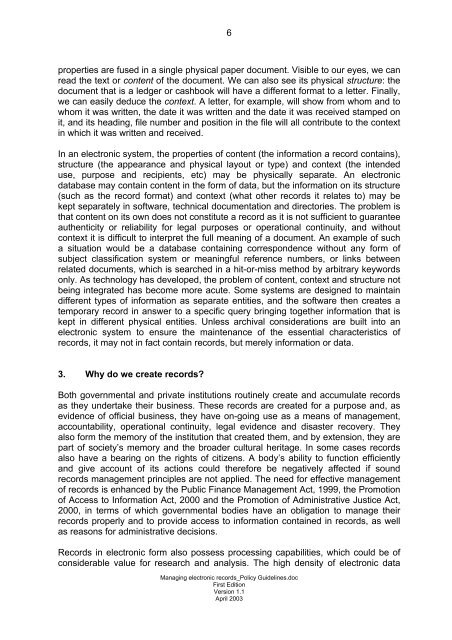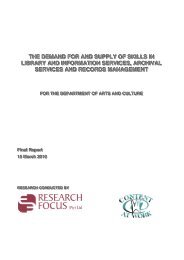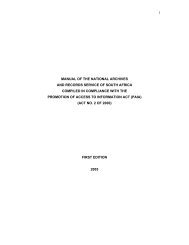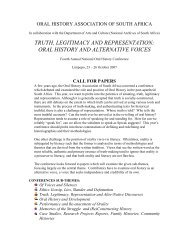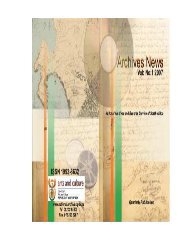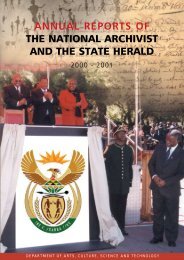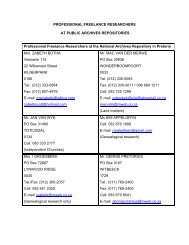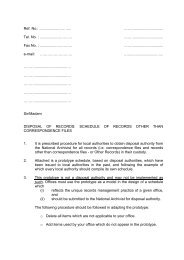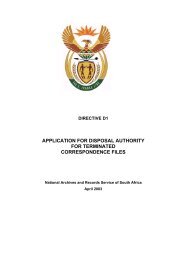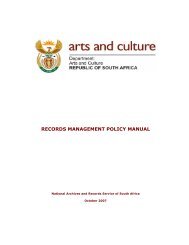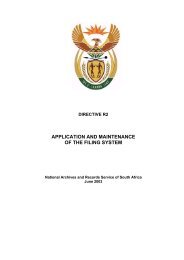managing electronic records in governmental bodies - National ...
managing electronic records in governmental bodies - National ...
managing electronic records in governmental bodies - National ...
Create successful ePaper yourself
Turn your PDF publications into a flip-book with our unique Google optimized e-Paper software.
6<br />
properties are fused <strong>in</strong> a s<strong>in</strong>gle physical paper document. Visible to our eyes, we can<br />
read the text or content of the document. We can also see its physical structure: the<br />
document that is a ledger or cashbook will have a different format to a letter. F<strong>in</strong>ally,<br />
we can easily deduce the context. A letter, for example, will show from whom and to<br />
whom it was written, the date it was written and the date it was received stamped on<br />
it, and its head<strong>in</strong>g, file number and position <strong>in</strong> the file will all contribute to the context<br />
<strong>in</strong> which it was written and received.<br />
In an <strong>electronic</strong> system, the properties of content (the <strong>in</strong>formation a record conta<strong>in</strong>s),<br />
structure (the appearance and physical layout or type) and context (the <strong>in</strong>tended<br />
use, purpose and recipients, etc) may be physically separate. An <strong>electronic</strong><br />
database may conta<strong>in</strong> content <strong>in</strong> the form of data, but the <strong>in</strong>formation on its structure<br />
(such as the record format) and context (what other <strong>records</strong> it relates to) may be<br />
kept separately <strong>in</strong> software, technical documentation and directories. The problem is<br />
that content on its own does not constitute a record as it is not sufficient to guarantee<br />
authenticity or reliability for legal purposes or operational cont<strong>in</strong>uity, and without<br />
context it is difficult to <strong>in</strong>terpret the full mean<strong>in</strong>g of a document. An example of such<br />
a situation would be a database conta<strong>in</strong><strong>in</strong>g correspondence without any form of<br />
subject classification system or mean<strong>in</strong>gful reference numbers, or l<strong>in</strong>ks between<br />
related documents, which is searched <strong>in</strong> a hit-or-miss method by arbitrary keywords<br />
only. As technology has developed, the problem of content, context and structure not<br />
be<strong>in</strong>g <strong>in</strong>tegrated has become more acute. Some systems are designed to ma<strong>in</strong>ta<strong>in</strong><br />
different types of <strong>in</strong>formation as separate entities, and the software then creates a<br />
temporary record <strong>in</strong> answer to a specific query br<strong>in</strong>g<strong>in</strong>g together <strong>in</strong>formation that is<br />
kept <strong>in</strong> different physical entities. Unless archival considerations are built <strong>in</strong>to an<br />
<strong>electronic</strong> system to ensure the ma<strong>in</strong>tenance of the essential characteristics of<br />
<strong>records</strong>, it may not <strong>in</strong> fact conta<strong>in</strong> <strong>records</strong>, but merely <strong>in</strong>formation or data.<br />
3. Why do we create <strong>records</strong><br />
Both <strong>governmental</strong> and private <strong>in</strong>stitutions rout<strong>in</strong>ely create and accumulate <strong>records</strong><br />
as they undertake their bus<strong>in</strong>ess. These <strong>records</strong> are created for a purpose and, as<br />
evidence of official bus<strong>in</strong>ess, they have on-go<strong>in</strong>g use as a means of management,<br />
accountability, operational cont<strong>in</strong>uity, legal evidence and disaster recovery. They<br />
also form the memory of the <strong>in</strong>stitution that created them, and by extension, they are<br />
part of society’s memory and the broader cultural heritage. In some cases <strong>records</strong><br />
also have a bear<strong>in</strong>g on the rights of citizens. A body’s ability to function efficiently<br />
and give account of its actions could therefore be negatively affected if sound<br />
<strong>records</strong> management pr<strong>in</strong>ciples are not applied. The need for effective management<br />
of <strong>records</strong> is enhanced by the Public F<strong>in</strong>ance Management Act, 1999, the Promotion<br />
of Access to Information Act, 2000 and the Promotion of Adm<strong>in</strong>istrative Justice Act,<br />
2000, <strong>in</strong> terms of which <strong>governmental</strong> <strong>bodies</strong> have an obligation to manage their<br />
<strong>records</strong> properly and to provide access to <strong>in</strong>formation conta<strong>in</strong>ed <strong>in</strong> <strong>records</strong>, as well<br />
as reasons for adm<strong>in</strong>istrative decisions.<br />
Records <strong>in</strong> <strong>electronic</strong> form also possess process<strong>in</strong>g capabilities, which could be of<br />
considerable value for research and analysis. The high density of <strong>electronic</strong> data<br />
Manag<strong>in</strong>g <strong>electronic</strong> <strong>records</strong>_Policy Guidel<strong>in</strong>es.doc<br />
First Edition<br />
Version 1.1<br />
April 2003


